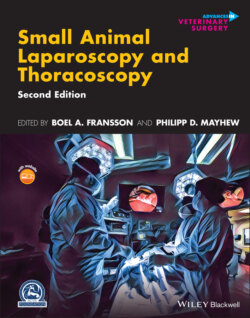Читать книгу Small Animal Laparoscopy and Thoracoscopy - Группа авторов - Страница 95
Scissors
ОглавлениеIn veterinary surgery, endoscopic scissors are used for more advanced procedures, such as for transection of the common bile duct in laparoscopic cholecystectomy, transection of the pulmonary ligament of a caudal lung lobe in thoracoscopic lung lobectomy, thoracoscopic subtotal pericardiectomy, or cutting intracorporeal sutures (Figure 4.7). Curved Metzenbaum scissors are the most versatile for tissue transection and dissection. When used with a handle–shaft assembly with a connector for monopolar electrocoagulation, hemostasis may be achieved while cutting. Metzenbaum scissors are also available with straight blades and with long, fine blades (curved or straight) for finer dissection. Other dissecting scissor types include operating scissors with serrated blades, blunt‐tipped scissors, sharp‐tipped scissors, and micro‐dissection scissors. Blades can be fine or robust, long or short, and straight or curved for most scissor sizes and shapes. Hook scissors have a wider, single‐action blade that engages a thinner, stationary blade. Both blades are hooked toward each other. Hook scissors are used to cut suture intracorporeally, and the hook design hinders suture slippage during transection of the suture. All scissors are used with nonlocking handles.
